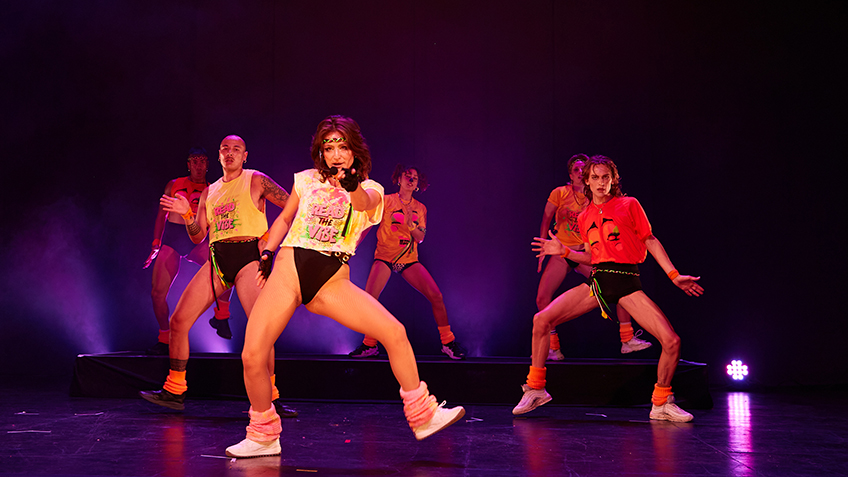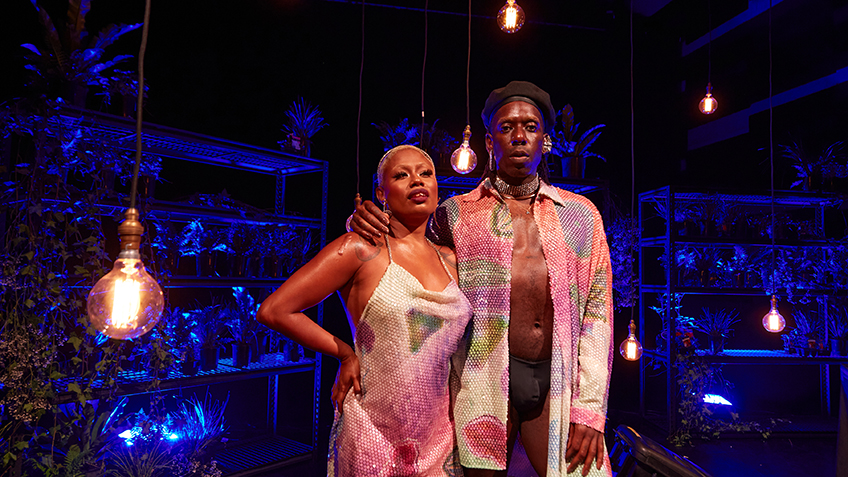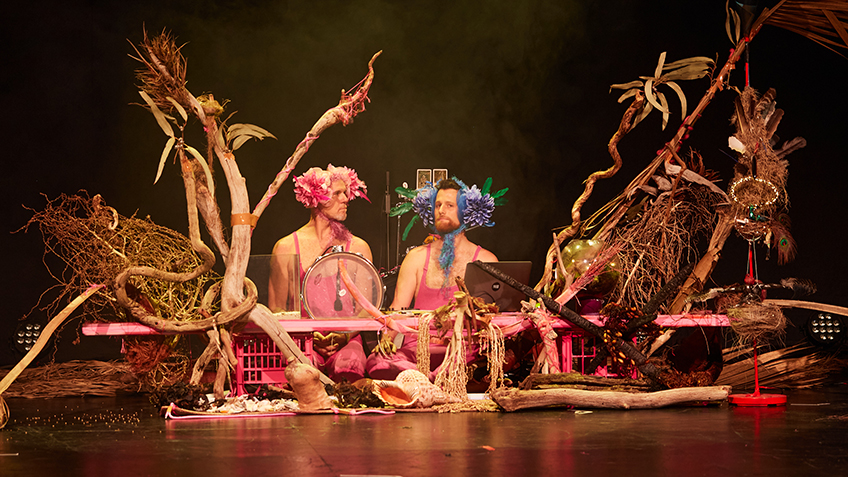Writer in residence Fiona Kelly McGregor on Performance Space’s Liveworks Festival of Experimental Art, online from 20-24 October 2021.
I didn’t want to go to Liveworks 2021 because it wasn’t live. I am not very good at attending online events. I am on a screen most of the day writing and reading; by evening I just want the tangible world, and when it comes to performance, I want to be in the space with the artists’ bodies and have all my senses engaged. My attraction to the form was always, even decades ago before I began to perform, informed by this desire for physicality. As a reaction against the cultural taboos I grew up with, as well as a literary culture uncomfortable with the body.
But I am so glad I did. The first event I was able to see was dancer Ivey Wawn’s video followed by a conversation with Lizzie Thomson. Wawn’s reflections expanded my naïve desire for physicality. By interrogating how much the articulation of a body – with all its determinants of size, strength, colour, ability and so on – defines one’s place in, and is in constant conversation with, the world. Wawn underpins this with her studies of political economy, highlighting capitalism.
In Perpetuity was based on dressage. Costume designer Verity Mackey clad Wawn and dancers Niki Verrall and Zachary Lopez in dark leotards and painted-on socks. Gender and racial differences dissolved. Arms immobile, they high-stepped singly then together in formation across the floor to a soundtrack of brass and snare drum. Daniel Jenatsch’s simple militaristic composition had a menacing quality, with spaces of high strings where the dancers gambolled and flailed their arms like horses wanting to bolt. This proposition of control, of humans by a system, and of animals by humans; of the gratuitous entertainment but also eccentric beauty that the pageant of dressage offers became more sinister as the video went on: close-ups of their faces revealing reddened eyes, oozes of blood. The wobble of thigh and breast gave the work a touch of the spilling, rebellious body.
It was a perfect example of how the digital format, with its seamless combination of long shots and close ups, of performance flush with discussion, can work. There was a beautiful irony here, in how work that examined the ineluctable body was, in fact, disembodied.
In the middle of the week, the night before Liveworks Festival began, ABC’s 7.30 Report aired a segment about the return of live theatre after 106 days of lockdown in Sydney. It was a generous, optimistic story, but considering it was almost six minutes long, you have to wonder why the only artists and events focussed on were from musical theatre. It’s impossible to know whether this narrow view is a result of the funding cuts bedevilling the national broadcaster for a good 20 years now, or a genuine lack of interest in non-commercial forms by reporter Laura Francis and her producers.
It seems to me that the problem of small audiences for performance art and experimental dance and theatre has increased since Performance Space moved to Carriageworks. It isn’t just that Performance Space has been given less than what was originally promised; it is also that the events they do put on – such as Liveworks – persistently attract smaller audiences than they deserve. So to see Liveworks delimited – right when things were opening up – to streaming – felt so disappointing. It filled me with admiration to see the curators and artists forge on and take advantage of what was there: after all, if we never have another lockdown, there’ll never be another chance to do the festival like this. The other thing that has emerged over the eighteen months that Covid-19 has ravaged the planet, is the opportunities that online arts events present to dissolve borders and time zones in both artist and audience participation.
Maybe the work I was most reluctant to watch was Day for Night. I couldn’t see how a long interactive performance/dance party, already reduced from 12 to five hours, could work, especially through a laptop as I couldn’t get it to sync with my Smart TV. I was, like millions of people, over it.
Teeny came over and we settled in front of the laptop with a cup of tea. As soon as hosts Kelly Lovemonster and Stelly G came on to introduce the evening’s entertainment, we perked up. They were dressed to the nines, Kelly’s African-style hat the crowning glory. In these sequences, the staging at Carriageworks was sometimes discernible; at other times the artists floated in a pixelated universe. Their excitement was infectious.
Behind them on the decks, Stereogamous (Jonny Seymour and Paul Mac) began to punch in tunes. The first act was Betty Grumble (Grumble Boogie) with old crew Megana Holiday, Sarah Jessica Carpark, Tommy Misa, Viliani Manukia and more. They got the blood warm with a medley of disco dances, vibrating as ever on the knife edge between dagginess and grooviness.
Maori/Samoan non-binary artist Jamaica Moana gave a performance with a focus on Maori language. Here, frustratingly, my connection failed, as well as during the performance by newcomer imbi. But I did see enough to appreciate the range of acts, including two artists I hadn’t seen before: Demon Derriere, a vampy purry, bootylicious POC, who did a burlesque number with an activist slant. Derriere is HoH (hard of hearing) and interacts with her soundtrack on a level of vibration rather than straightforward aural reception. Seann Miley Moore, who cut their teeth in musicals and pop music in the UK, sang a couple of numbers in an ingenious tight off-the-shoulder dress made of black plastic.
Interspersed with the live feed was a little video story by queer film collective Garden Reflexxx starring Stelly G, set at an inner west train station (Petersham? Stanmore? Lewisham?). Each chapter opened with a long shot down the platform facing the dusky west, Stelly mounting the stairs at the end in a bright flowing robe and turban and glasses with lime green frames, to make a phone call in the public telephone box (wow, they still exist!). You couldn’t understand much apart from fucken fuck … fuck! Yo bitch … yeah I know aww … come on ya fucken …!
But you didn’t need to understand the words. The graphics were great: images dissolving into tableaux of what looked like a sort of bastardised coding; lots of fluoro greens and swirling oceanic spacey backgrounds. Witty maxims traversed the screen. Bye bye binary … men can be mothers. Behind, on the decks, Paul and Jonny were going off. Kelly and Stelly G reappeared in new costumes, even more excited, and the event took on the rhythm of a party, becoming looser, funnier, sexier as the night went on. We poured a whisky. We rolled a joint. The feed began to include punters grooving in their living-rooms, some from hundreds of kilometres away.
How about Dean Walsh in his duo Weird Nest with partner Andrew Batt Rawden? Costumed in sort of flapper frocks with flat chests and floppy frills around the hips, pink leggings and pink pumps with giant pink bows and ridiculous hats and head-dresses, most memorably one with pink horizontal feathers that would’ve poked your eyes out if you’d been in the bar queue with them. They pranced on stage in front of Rawden’s bank of musical equipment and danced like leprechauns, madmen, otherworldly creatures half insect half bird, all angles and wide eyes, rolling around on the floor jumping up again. The most divinely bizarre cavort I’ve seen in ages. Rawden alternated behind on the keyboard tweaking disco electronica while downstage, Walsh enthralled us with high-kicking hip-swaying wrist-bending action.
The lighting for this and in fact every performance was warm and moody as a nightclub yet always giving the performing bodies clarity; the installations they moved through were impossible to decipher in an exact sense which was what was so magical about it and, again, such an astute use of the digital format. Sidney McMahon, the installation artist, and Calum Young, the lighting designer, deserve a standing ovation; I came away feeling as though I’d wandered through a garden of earthly delights. It was a wonderful mystery; not a stick of scaffolding in sight.
At some point Joe Pol knocked at my front door with gifts of punnets of capsicum seedlings and some flowers. Then Aaron Manhattan came an hour later with more plants, and we gave him a whisky. The main thing I took away from Day For Night was that people are champing at the bit to get out. Open the doors and we will pour through to dance, perform, make art, hug each other; the skill, spirit and sexiness surviving these hard Covid times. The only problem was that it was so captivating we arrived late at The Order of Autophagia, the midnight dinner party.
The brainchild of Natasha Tontey, this production was, I’m pretty sure, beamed from Indonesia, where the artists live and work. Tontey is a graphic designer and digital and performance artist from Yogyakarta, working in the realm of futurism and speculative fiction with much of Autophagia developed in a micro-fellowship with Performance Space. The fetching image that advertised this year’s Liveworks, of an androgynous figure in whiteface with white/blue eyes, a pencil thin curling moustache and kiss curls, was B.M. Anggana, co-dramaturg and performer (underneath, he’s wearing a nappy – all night, actually). Ahmad Susantri and Arsita Iswardhani rounded off the quartet.
Autophagia, (supper of terror, lunch for the uncanny, Unapologetic Snacks on the apocalyptic moment) is a look at our habit of over-consumption. During the intro, various body parts are served on platters: fingertips with long red nails, a brown (chocolate) foot, giblets of some sort, a cocktail of what appears to be blood filled with eyeballs, all sugary bright. The performers devour them, Susantri licking a hunting knife dripping with fake blood. A midnight feast that as Liveworks Festival’s Artistic Director Jeff Khan says, puts the ‘gross’ back into engrossing.
Live in a studio, before manipulated graphics, the four artists cavort in warped maid’s costumes with hearts and bums cut out, the two women often wearing three breasts each. Structured as a feast, beginning with an appetiser, Autophagia was a video art trip in the tradition of grand guignol theatre. Or, perhaps, surrealist bacchanalian cinema most famously evinced by Jodoroswky’s The Holy Mountain, blessedly purged of the Latin American opus’s poor gender politics. The ‘Chef d’Oeuvre’ was Vaginal Yeast or Sugar Baby Love.
‘As we drink mother’s milk, we famously consume other bodies,’ Susantri declared in the high-pitched babble – often, I think, in Bahasa – all the characters used. The dialogue was difficult to understand, at times grating, but charming in its absurdity. The background graphics morphed from a night sky constellation, through an inferno to swirls of something between red meat and plastic. A work that could be further developed to find the more serious aspects of the themes it proposes, perhaps trimmed. The midnight timeslot is genius. Like Day for Night, being broadcast on Zoom welcomed interventions from audience members every so often.
***
Earlier this year, not knowing much about it, I booked for Sue Healey’s On View: Panoramic Suite – the live interactive iteration – at Sydney Town Hall. But it was one of thousands of live events across the continent quashed by lockdown. I hope it still gets a run there, or an equivalent space (soaring ceilings) as it’s a monumental work that invites perambulation and interaction. Created as a seven-channel interactive dance installation, it made me long – again – to be in the same physical space as these bodies, to experience random moments of intimacy, unexpected angles, to be among the audience exchanging responses, to hear the impact of feet, hands, the movement of breath and feel the room temperature change.
The video nevertheless holds up on its own, probably because the performative talent is so abundant, the standard so high, and as the project was made over an eight-year period with more than 100 dancers, there must be hundreds of hours of material to choose from.
Martin del Amo introduces the work performing as MC throughout, leading the viewer from one scenario to another. The variation between dances done for screen and in situ is approximated by a contrast between landscapes and studio work, but part of the nimbleness of the editing is that the work on screen features both in and of itself, and as a physical entity into which the viewer is inducted. To this extent, there is no artifice. And what remarkable landscapes: a mesa – or dry lake – some vast expanse of earth covered in shorn grass with a thin line of blue sky and clouds in the distance filmed by a drone, the dancer swathed in swirling fabric, close ups of his feet lifting dust and grass. A cityscape – concrete – on which a smaller man, his face and neck covered in clay, rolls and contorts.
Some of the dancers introduce themselves, describing to the camera what dancing means to them, what and how they express their art, articulations that took me back to the Wawn Thomson conversation. On View: Panorama was astonishing and I can’t wait to see it as a dance installation.
I wish I’d had the time to see more of Liveworks. I was so impressed with what I did catch. Most of all I want to revisit the conversations and works done between different time zones (including for instance, SJ Norman and Joseph M. Pierce’s Knowledge of Wounds project which has since migrated to their own website). Maintaining such platforms now we can again gather in the flesh has the potential for greater connections than ever before.
Written by Fiona Kelly McGregor





